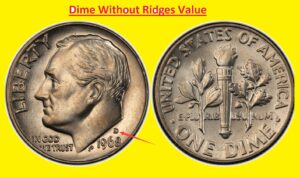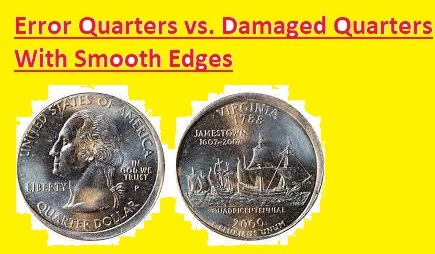Hi friends welcome to the new post. Here we will learn Dime Without Ridges Value – No Ridges Around Edge! It is easy to define that Roosevelt dimes are forgotten coins. Billions of coins were made and small size coins faced thousands of hands every day. Here we will discuss the world of dimes without ridges and find their importance in the coin community. Sol et get started with Dime Without Ridges Value
History of the Roosevelt Dime
The first minting year of Roosevelt’s dime is 1946. At this time US coinage started the designs of the coins that have photos of Franklin D. Roosevelt. This dime became the replacement of older minted mercury dimes.
- The first production was made from (1946-1964), Roosevelt dimes were made with a 90 percent silver composition.
- The design was made by John R. Sinnock. His initial was added on the lower of Roosevelt’s neckline.
- Among the modern coins used for circulation, Roosevelt dimes are still unchanged. While other coins have faced many changes and desing of Dime also not changed since 1946.
- The basic change made in these dimes is the removal of the silver composition. It was changed in 1965
Dimes Without Ridges
Dimes without ridges are also known as smooth-edge dimes and are famous for coin collectors.
Smooth Edge Dimes
Smooth edge dimes have reeded edges. it has a continous edge and is different from other coins
Smooth Edge Dimes collection
- Their rarity defines the collection of these coins
- The condition also factors that help to find these coins and their value.
- Their mint mark is also a main factor in coin collections
Dime Without Ridges Value
The dime not having a ridge over the edge is known as broadstrike. It is an error on coins that occurs when struck with a larger force making flate-shaped coins.
These coins not common can be of high value. The value of broad strike dime is based on mint condition and rarity. Generally, broad strike dimes of the 1960s and 1970s are less valuable.
Uncirculated brode strike dimes are of high value about a hundred dollars and circulated conditions are of 100 dollars.
Error Quarters vs. Damaged Quarters With Smooth Edges
The main difference in these coins is their manufacturing process. Error quarters are the result of errors during the minting process and damaged quarters with smooth edges are worn down from circulation.
Error quarters due to misaligned die for coin striking with force and coins struck on the wrong planchet. This error can cause different markings on coins such as doubled dies, off-center strikes, or missing features.
Damaged quarters having smooth edges are affected during circulation and not proper handling. The ridges on the edge of quarters help to avoid counterfeiting but can wear with time.
if quarters are damaged ridges are smooth, error quarters are then damaged with smooth edges and are rare coins and some.
Most valuable quarter ridges
High-value quarter ridges come with brown strike errors. The broad strike error quarter struck with a high effect on change on dia of coins.
it resulted in coins with smoother edges as compared to reeded edges.
Broadstrike error quarters are high-value Washington quarters made before 1965 when the mint used a new coin press that made sharper reeded edges.
This older broak strike quarters are of about 125 dollars or higher, based on condition.
The quarters made after 1965 are of low value of 20 dollars. Bicentennial quarters made in 1976 of smooth edges are rare and their value is 30 dollars.
How To Tell If A Smooth Edge Quarter Is A Broadstrike Error Coin
- Coins not have a reeded edge are broads-tike coins.
- The coin of the broad strike has a larger width as compared to other coins.
- Broadstrike coins come with high weight than other coins
- There can be off-center striking or doubled dies.
Are dimes without mint marks valuable?
Some dimes of 1982 and 1983 were made without mint marks and these coins are preffered for collectors. Some 1982 dimes struck by P mint in 1982 made with obverse die that did not have a P mint mark. These coins can sell for 65 dollars.
What happens if a quarter doesn’t have ridges?
Some error quarters made without ridges are called broad strikes, 1997 quarters without ridges are of value about 15 dollars to 30 dollars.
These coins are missing some parts of the design due to misalignment between the die and planchet at the time of manufacturing.
How many ridges does a dime have around the edge?
Mint added reeded edges to coins there are 118 ridges on dimes 150 on half dollars 119 on quarters and 133 on Susan B.
What coin does not have ridges?
Nickles in the US do not come with ridges, unlike other coins since they are created with the use of less-cost metallic alloy. Ridges are added to coins that have costly metals to avoid people shaving off small parts of metals and save the coin value.
Dime Composition and Melt Value
1946-1964
- Weight=2.5 grams
- Metal composition=90% silver, 10% copper
- Melt value=. $2.89
1965-Present
- Weight=2.27 grams
- Metal composition=75% copper, 25% nickel
- Melt value–appro=. $0.02
Read Also:
Faqs
- Which dimes with no mint mark are worth money?
The 1975 no-S proof Roosevelt dime, and it is also conditioned with some proof dimes of 1968, 1970, and 1983. proof Roosevelt dimes of these years are without the S mint mark and these are rare and valued of hundreds or thousands of dollars apiece.
- How do you know if a dime is valuable?
Check the condition of the dime with the use of grading sale of professional coins grade service. Coin in good condition normally are high value.
- What type of dime is rare?
- What rare dime is worth $2000?
1982 “No P” dime is a rare type of dime and can have a value $2,000 (or more).
- What dime is worth $1 million?
Like the million dollars or two, the 1894 S dime was made at S mint. There were 24 coins made and 9 exist.
- How much is 2 million dimes?
2 million dimes is $200,000.
- How much is 1 cent in dollar?
1 cent is equal to $0.01. 1 dollar is equal to 100 cents, so 1 cent is 0.01 dollars. 1 nickel is 5 cents, so 1 nickel is 0.05 dollars.
- What is 1 penny in dollars?
| Pennies | Dollars |
|---|---|
| 1 | 0.01 |
| 10 | 0.1 |
| 50 | 0.5 |
| 100 | 1 |
- What is 1 dime in dollars?
| Value | 0.10 U.S. dollar |
| Mass | 2.268 g (0.0729 troy oz) |
| Diameter | 17.91 mm (0.705 in) |
- How much is one dime in Pakistani rupees?
| Amount | Today at 11:49 am |
|---|---|
| 0.5 DIME | PKR 0.0049 |
| 1 DIME | PKR 0.0098 |
| 5 DIME | PKR 0.0492 |
| 10 DIME | PKR 0.0985 |
- How much is 1 penny?
| Pennies | Dollars |
|---|---|
| 1 | 0.01 |
| 10 | 0.1 |
| 50 | 0.5 |
| 100 | 1 |
- What are the 4 types of coins?
The 4 types of coins are: Penny Nickel Dime and Quarter
- What dimes have no ridges?
Dimes with no ridges
Broadstrike are without ridges
How many ridges around the edge does a dime have?
A dime has 118 ridges around the edge.
Do dimes have smooth edges?
Different coins like quarters and dimes do not have a reeded edge. Reeding of edges was used to avoid coin clipping and counterfeiting.
What is a 1947 dime worth today?
| PrAg | G | VF |
|---|---|---|
| $2.65 | $2.65 | $2.65 |
Which coins have ridged edges?
Some coins like United States quarters and dimes, 1 euro, Australian 5, 10, 20 cents, 1 and 2 dollars, and other comes with reeded edges.
How can you tell if a dime is rare?
if there are any dimes made before 1917, are not only rare but not easy to find in circulation. These old coins come with Bust dimes, Liberty Seated dimes, and Liberty Head (or “Barber”) dimes
What is the rarest type of dime?
1894-S Barber Dime of value $1,997,500 is the rarest type of dime just nine exists
What are the two sides of a dime?
. The front is the side with the image of Franklin D. Roosevelt. The back side with the word Liberty and the year of minting.








